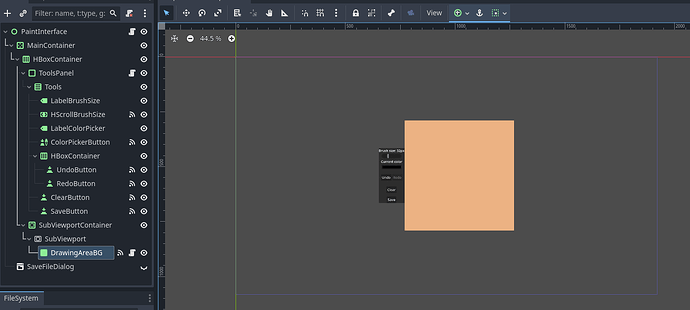So, if anyone is ever interested, I finally figured it out!
As it turns out, if you try to use a Control node that is intended to display stuff such as any kind of UI element or a simple Panel or ColorRect, you can use it to draw but when the drawing is on top of itself it will always clear itself and reapply itself, regardless of its Viewport clear mode. Here is an example of this behaviour in a minimal setup (drawing a circle from a call to redraw (with the mouse position as center of the circle) in _process):
No matter what you do, any child or other node that has a higher z-index as such a Control node and tries to draw on top of it will be subject to this behaviour. However, you can have a setup similar to this one:

And then you can hide the drawing area bg after it has been drawn once and since the Viewport is never clearing itself it will still appear as a background on top of which you can draw. This is still not great though, as clearing your drawing or undoing it will require re-showing the background node and it will get very messy as you end up having to delay your next draw calls to after the node has drawn itself and re-hidden itself, etc.
So in the end, my best solution was to simply draw my background color myself, as a draw_rect for example, and then I can use the viewport clear mode properly. I give my code as a reference for future interested readers, although I’m sure it’s not particularly clean nor efficient:
Code
extends Control
#This is just an enum to know what to do next, it's all managed in another script on my subviewportContainer
var draw_act : PaintManager.DRAW_ACTION = PaintManager.DRAW_ACTION.CLEAR
var strokes : Array[PaintManager.Stroke] = []
var redo_strokes : Array[PaintManager.Stroke] = []
var last_drawn_index : int = 0
func _draw() -> void:
match draw_act:
PaintManager.DRAW_ACTION.ADD:
if strokes.is_empty():
return
var current_stroke = strokes[-1]
var current_last_index = current_stroke.stroke_points.size() - 1
for index in range(last_drawn_index, current_last_index):
var point = current_stroke.stroke_points[index]
draw_colored_polygon(generate_circle_polygon(current_stroke.brush_size / 2.0, 72, point), current_stroke.brush_color)
if index > 0:
if current_stroke.stroke_points[index - 1].distance_to(point) >= current_stroke.brush_size / 4.0:
draw_line(current_stroke.stroke_points[index - 1], point, current_stroke.brush_color, current_stroke.brush_size, true)
last_drawn_index = current_last_index
PaintManager.DRAW_ACTION.UNDO:
draw_rect(get_viewport_rect(),Color("ecb283"))
if strokes.is_empty():
return
for stroke in strokes:
if stroke.stroke_points.size() >= 1:
draw_colored_polygon(generate_circle_polygon(stroke.brush_size / 2.0, 72, stroke.stroke_points[0]), stroke.brush_color)
if stroke.stroke_points.size() == 1:
continue
var previous_pos := stroke.stroke_points[0] as Vector2
for point in stroke.stroke_points:
draw_colored_polygon(generate_circle_polygon((stroke.brush_size) / 2.0, 72, point), stroke.brush_color)
if previous_pos.distance_to(point) >= stroke.brush_size / 4.0:
draw_line(previous_pos, point, stroke.brush_color, stroke.brush_size, true)
previous_pos = point
draw_act = PaintManager.DRAW_ACTION.ADD
PaintManager.DRAW_ACTION.CLEAR:
draw_rect(get_viewport_rect(),Color("ecb283"))
draw_act = PaintManager.DRAW_ACTION.ADD
And the accompanying PaintManager on my SubViewportContainer:
extends SubViewportContainer
class_name PaintManager
class Stroke:
var brush_color : Color
var brush_size : int
var stroke_points := []
func _init(point, color: Color, size: int):
self.stroke_points = []
self.stroke_points.append(point)
self.brush_color = color
self.brush_size = size
signal added_to_redo()
signal emptied_redo()
@onready var sub_viewport = $SubViewport
@onready var painter = $SubViewport/Painter
var brush_color := Color.BLACK
var brush_size := 32
enum DRAW_ACTION {ADD, UNDO, CLEAR}
var ongoing_stroke : bool = false
var left_mouse_pressed := false
var mouse_inside_rect := false
var mouse_started_inside := false
func _ready():
sub_viewport.render_target_clear_mode = SubViewport.CLEAR_MODE_ONCE
func _process(_delta) -> void:
if !left_mouse_pressed:
return
if !ongoing_stroke:
return
if !mouse_inside_rect:
return
if painter.strokes.is_empty():
return
if painter.strokes[-1].stroke_points.is_empty():
return
var mouse_pos = sub_viewport.get_mouse_position()
# Check if the mouse is currently inside the canvas/drawing-area.
if sub_viewport.get_visible_rect().has_point(mouse_pos):
painter.strokes[-1].stroke_points.append(mouse_pos)
painter.queue_redraw()
func _gui_input(event) -> void:
if !(event is InputEventMouseButton) or (event is InputEventMouseMotion):
return
if !(event.button_index == MOUSE_BUTTON_LEFT):
return
if event.pressed:
left_mouse_pressed = true
#var mouse_pos = get_global_transform().affine_inverse() * viewport.get_mouse_position()
var mouse_pos = sub_viewport.get_mouse_position()
# Check if the mouse is currently inside the canvas/drawing-area.
if sub_viewport.get_visible_rect().has_point(mouse_pos):
mouse_started_inside = true
ongoing_stroke = true
painter.redo_strokes.clear()
emptied_redo.emit()
painter.strokes.append(Stroke.new(mouse_pos, brush_color, brush_size))
painter.queue_redraw()
elif not event.pressed:
left_mouse_pressed = false
ongoing_stroke = false
mouse_started_inside = false
painter.last_drawn_index = 0
func _on_redo_button_pressed() -> void:
if painter.redo_strokes.is_empty() or ongoing_stroke:
return
painter.strokes.append(painter.redo_strokes.pop_back())
painter.last_drawn_index = 0
if painter.redo_strokes.is_empty():
emptied_redo.emit()
painter.queue_redraw()
func _on_undo_button_pressed() -> void:
if painter.strokes.is_empty() or ongoing_stroke:
return
painter.redo_strokes.append(painter.strokes.pop_back())
added_to_redo.emit()
painter.draw_act = DRAW_ACTION.UNDO
#viewport.render_target_clear_mode = SubViewport.CLEAR_MODE_ONCE
RenderingServer.viewport_set_clear_mode(sub_viewport.get_viewport_rid(), RenderingServer.VIEWPORT_CLEAR_ONLY_NEXT_FRAME)
painter.queue_redraw()
func _on_clear_button_pressed() -> void:
painter.strokes.clear()
painter.redo_strokes.clear()
emptied_redo.emit()
painter.last_drawn_index = 0
painter.draw_act = DRAW_ACTION.CLEAR
RenderingServer.viewport_set_clear_mode(sub_viewport.get_viewport_rid(), RenderingServer.VIEWPORT_CLEAR_ONLY_NEXT_FRAME)
painter.queue_redraw()
func save_picture(path):
# Wait until the frame has finished before getting the texture.
await RenderingServer.frame_post_draw
# Get the viewport image.
var img = sub_viewport.get_texture().get_image()
# Crop the image so we only have canvas area.
var cropped_image = img.get_region(sub_viewport.get_visible_rect())#Rect2(global_position, size))
# Save the image with the passed in path we got from the save dialog.
cropped_image.save_png(path)
func _on_color_picker_button_color_changed(color) -> void:
brush_color = color
func _on_h_scroll_brush_size_value_changed(value) -> void:
brush_size = value
func _on_mouse_entered():
mouse_inside_rect = true
if (left_mouse_pressed and mouse_started_inside):
ongoing_stroke = true
var mouse_pos = sub_viewport.get_mouse_position()
painter.strokes.append(Stroke.new(mouse_pos, brush_color, brush_size))
painter.queue_redraw()
func _on_mouse_exited():
mouse_inside_rect = false
ongoing_stroke = false
painter.last_drawn_index = 0

